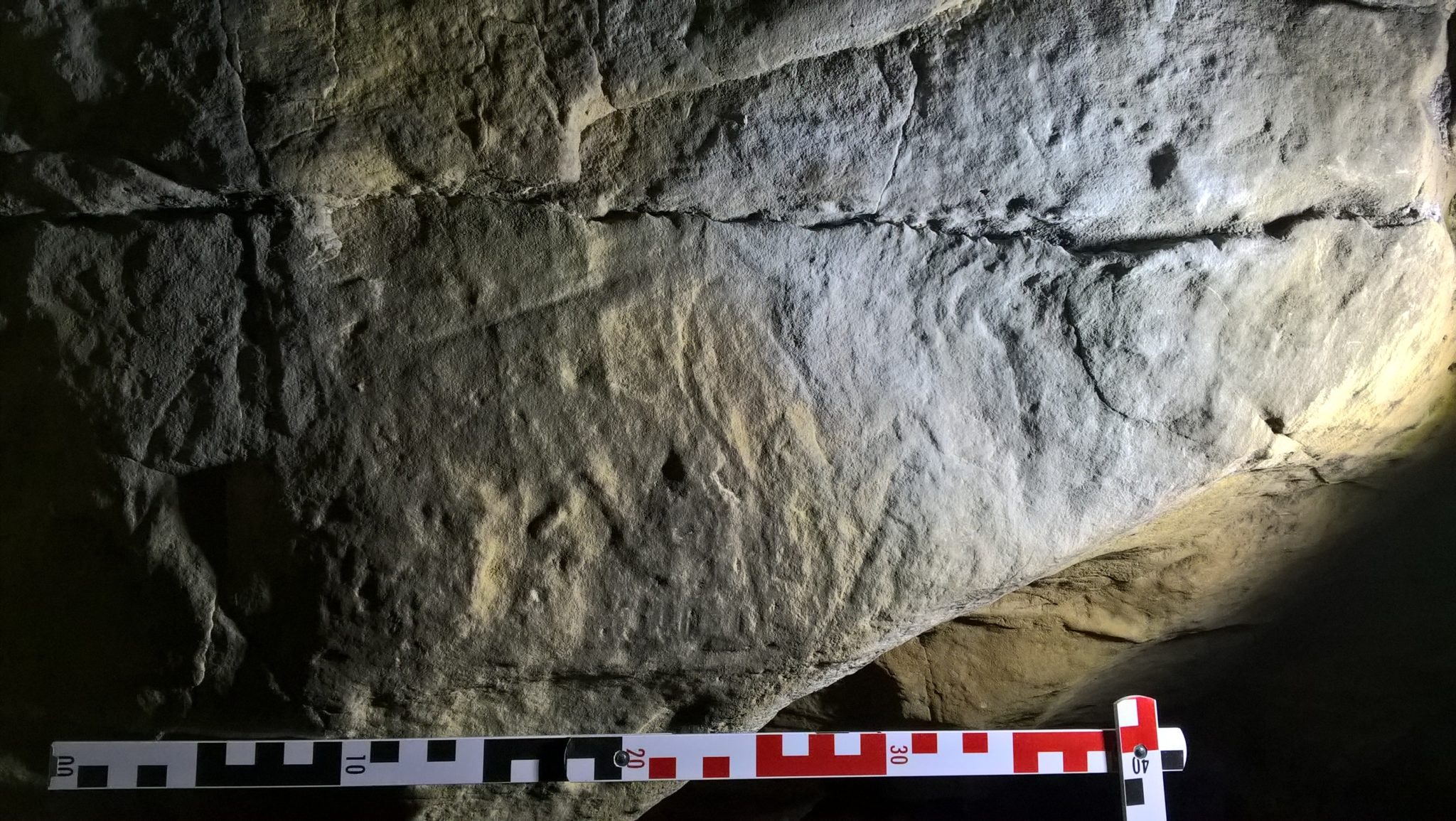
A large concentration of ritual protection marks have been discovered in caves in Creswell Crags, a limestone gorge on the Nottinghamshire/Derbyshire border. Darkness Below editor Linda Wilson visited the site with researcher and archaeologist Alison Fearn and gives an account of the find.
On Sunday 21st October 2018, cavers Hayley Clark and Ed Waters of the Mendip Caving Group visited Creswell Crags with other underground enthusiasts from the group Subterranea Britannica. In Robin Hood Cave, amidst the profusion of historic graffiti on the cave walls, they noticed some markings that reminded them of those found in caves under the Mendip Hills in Somerset.
Hayley told Darkness Below: “As well as the interest provided by the world-class prehistoric archaeology, our experience suggested that these caves were a promising place to look for protective marks. A few minutes of looking soon revealed several features that we thought might be protective marks. We pointed these out to our guide as we left the cave, and he seemed interested and stated that he would have a closer look.
“Thinking that our guide was just being polite, we thought nothing more of this until a message was posted on the Subterranea Britannica newsgroup asking for the ‘witch mark’ experts to step forward! We admitted responsibility, but denied we were experts and at this point we were informed of the exciting discoveries made by the team at Creswell.”
And Ed added: “We are flattered to have been a very small part of this, but it must be noted that all the hard work and real discoveries have been made by the staff at Creswell. It is, however, very pleasing that these guys took what we said back in October seriously and this sparked a seed of interest that has paid off in a most spectacular way.”
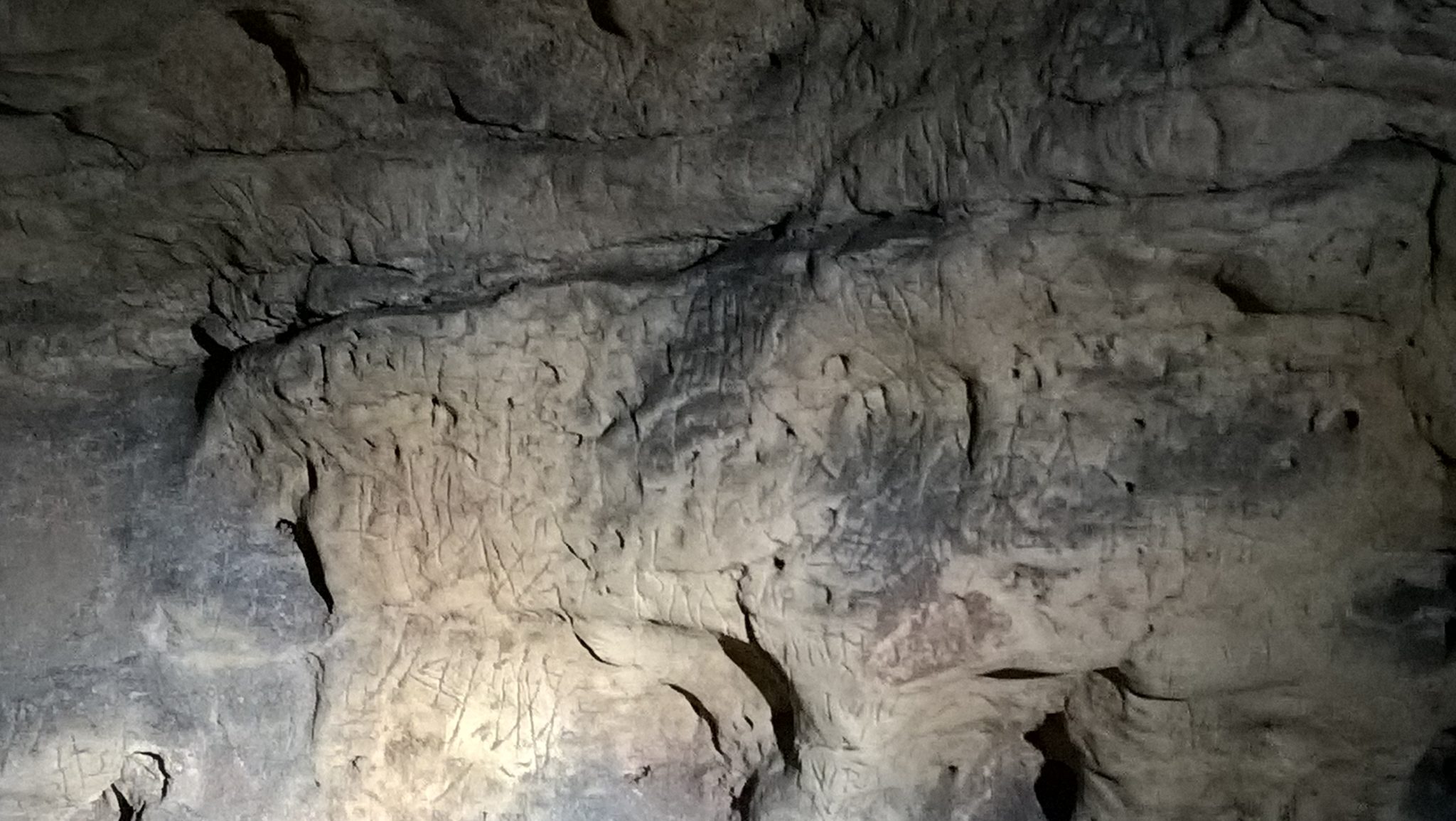
Picking out the single letters amidst the wealth of initials in the cave isn’t easy, but when one is seen, others quickly follow. One type of mark that immediately stands out amidst the proliferation of tourist graffiti is the conjoined VV first identified in a cave context in Goatchurch, Somerset. There are also numerous M markings of the type frequently found in Wookey Hole, Somerset.

Timothy Easton, an expert in protective symbols, says: “Scribed M and VV symbols are commonly found adjacent to initials where surfaces encourage individuals to record their presence, as well as being used elsewhere in association with other symbols interpreted as having apotropaic intent.”
Apotropaic is a Greek word meaning to ‘turn away’ and in this context it refers to turning away evil. The marks are commonly found in old buildings, especially around windows and fireplaces, which were believed in a superstitious age to be particular vulnerable to attack by witches, spirits and demons. Graffiti studies have shown that in terms of quantity, the VV symbol is by far the most numerous. It is believed that these VV marks were connected with the Virgin Mary, often referred to in Catholic prayers and litanies as Virgin of virgins.
Timothy adds: “The use of both these letter forms may well have derived from pre-Reformation monograms alluding to the Virgin Mary, but their subsequent use up to the 19th century has lost all connections to Mary’s image and her power to aid problems and requests for her intercession.”
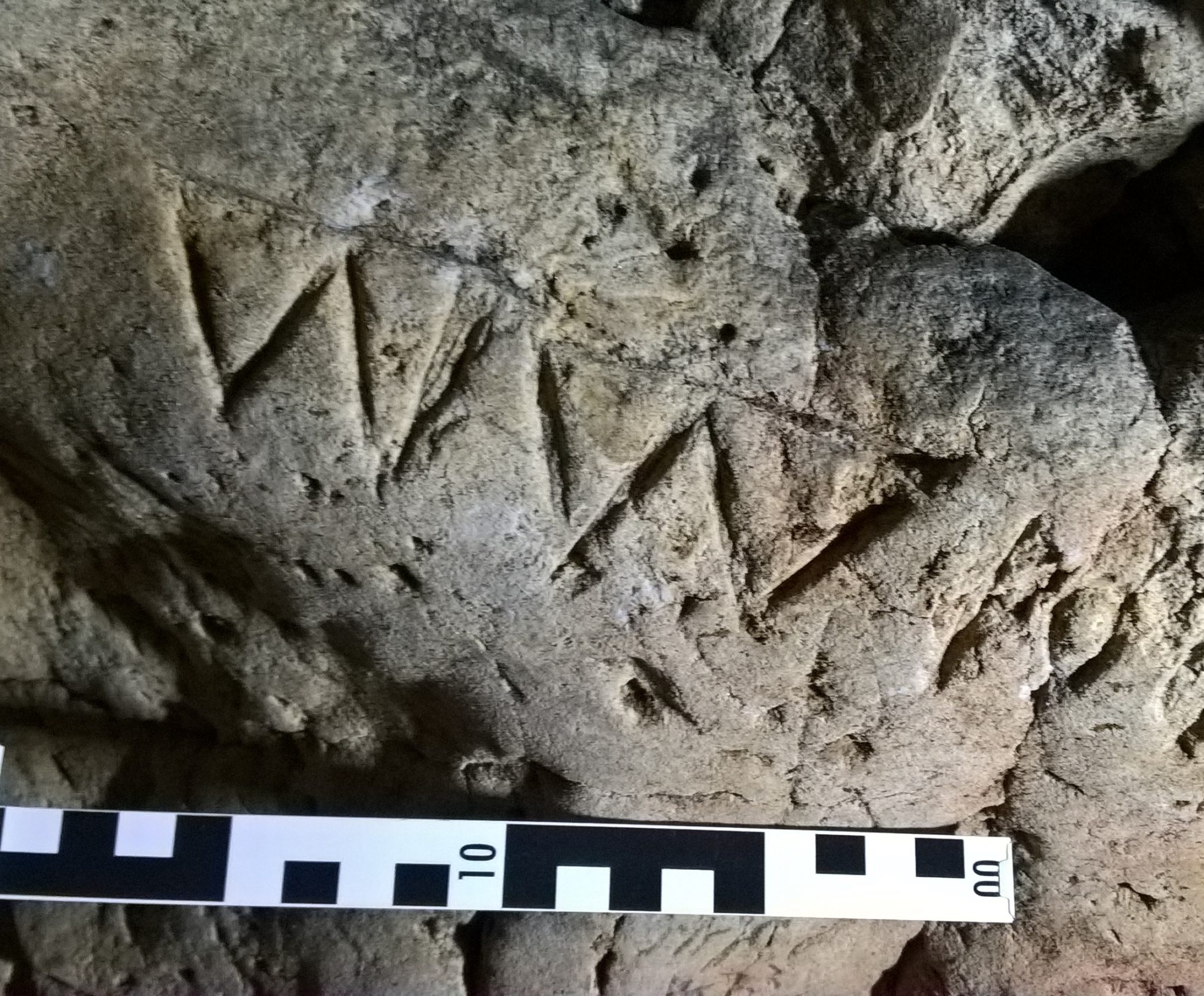
There are other enigmatic markings in the cave, including a pair of overlined VV marks which have parallels to a find on a stable door in Suffolk recorded and discussed by Timothy Easton in the newsletter of the Suffolk Historic Buildings Group in 2015.
These, and some very clear VV symbols, are found immediately over a deep pit in the cave floor. How much of this hole was excavated during the archaeological work carried out in the caves in the mid-1800s is not known, although as this now connects to lower passages. It is possible that some form of connection existed, which could explain the high concentration of marks in this small chamber, beyond the part of the cave accessible to visitors. If there was some form of hole in the floor in the chamber that was subsequently dug through, this would reflect the position of the marks in Goatchurch Cavern above a deep hole known as the Giant’s Steps, from which a noticeable cold draught emerges. In Wookey Hole, these type of marks are frequently found in conjunction with vertical features such as the Witch’s Chimney, which has one the highest concentration of marks in the cave.
It is clear from the excavation reports by Reverend JM Mello and William Boyd Dawkins in 1875-77 that this chamber was accessible prior to their work in the cave. They describe Robin Hood Cave as having “four or five large chambers, which have very evidently been used for human occupation.” In addition, they refer to finding “…some broken fragments of Roman and Medieval pottery, a human incisor, and some bones of recent animals…” There is an inscribed date of 1728 that pre-dates their work in the cave close to one of the VV marks, in a position that makes photography too risky to attempt.
Alison Fearn, a postgraduate researcher at the University of Leicester who has worked with staff at Creswell on this discovery says: “This is an exciting find which adds to the current state of knowledge. More and more caves are being recorded with these fascinating narratives. Creswell sits firmly with other known examples, and we’re only just unravelling the particular stories being expressed here.”
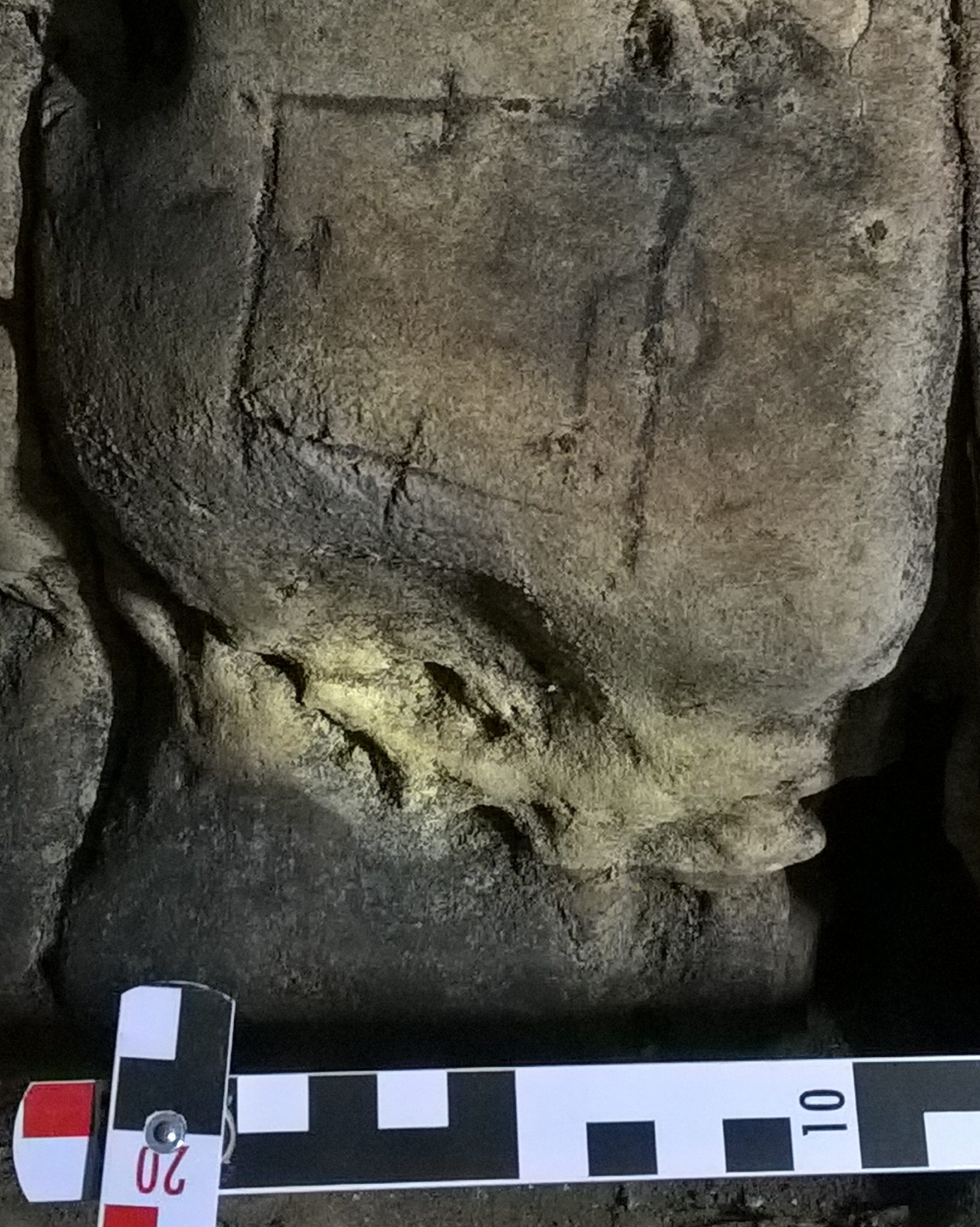
In the small hole that leads to the inner chamber, there is a mark resembling the type of engraving often associated with one of the many variants of the gaming board known as a merel, of which nine men’s morris is a common type. There is a superb example at Creswell on a stone block that was found in the 19th century spoil heap outside Church Hole during excavations in 2006. This appears to consist of a pair of merel boards, one inside the other. Merels are common in both religious and secular contexts and the fact that many of these are on vertical surfaces means that a protective function cannot be ruled out. The mark on the wall resembles the partial merels often found in both religious and secular contexts.
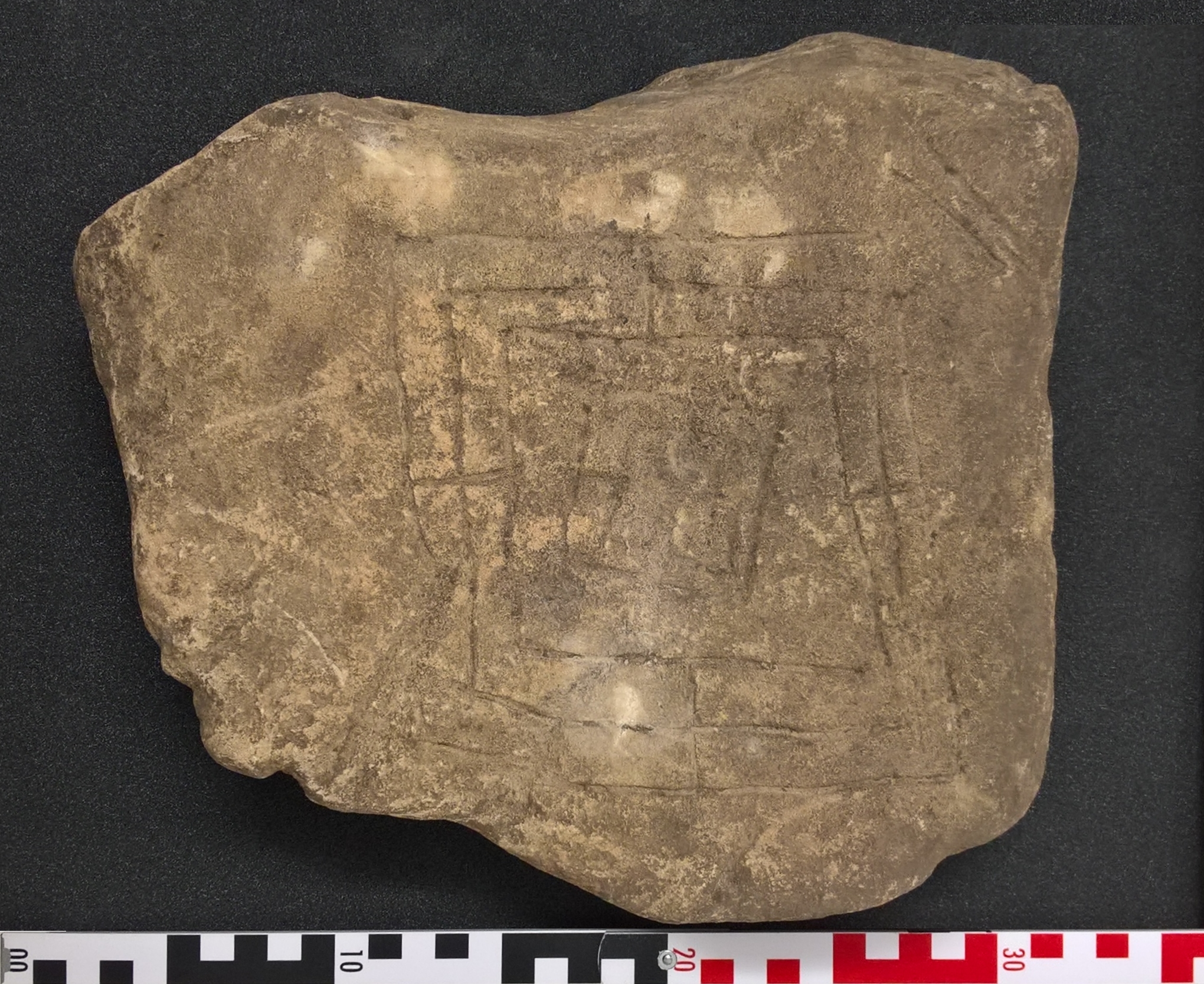
Professor Ronald Hutton of the University of Bristol, one of the world’s foremost authorities on the study of witchcraft, says of the news from Creswell: “This discovery is significant because it looks like the largest assemblage of protective marks ever found in British caves, and possibly anywhere in Britain. This is suddenly a large new area of research for historians and archaeologists, and so adds appreciably to the importance of the Crags as a world resource. This is a hugely important and exciting find, in one of the main current growth areas of knowledge about the past. Creswell Crags has already amazed the 21st century with its revelations of Palaeolithic designs. Now it does so again with a fresh one of medieval and early modern ritual protection marks on a huge scale, making a very important contribution, at a stroke, to one of the most significant current areas of scholarly research.”
The Palaeolithic art in Church Hole at Creswell was first recognised in 2003 by researchers Paul Bahn, Paul Pettit and Sergio Ripoll, and can now been seen by visitors to the Crags. Paul Bahn says of the latest news from the cave: “Creswell Crags has clearly been attracting people for many thousands of years – after all, the Neanderthal occupants were much farther removed in time from the cave artists than the latter are from us. So it is no surprise that the site – with its abundant shelters, its river and plentiful resources – would still have been a popular place in medieval times, as shown by the variety of markings recently recognised in its caves.”
